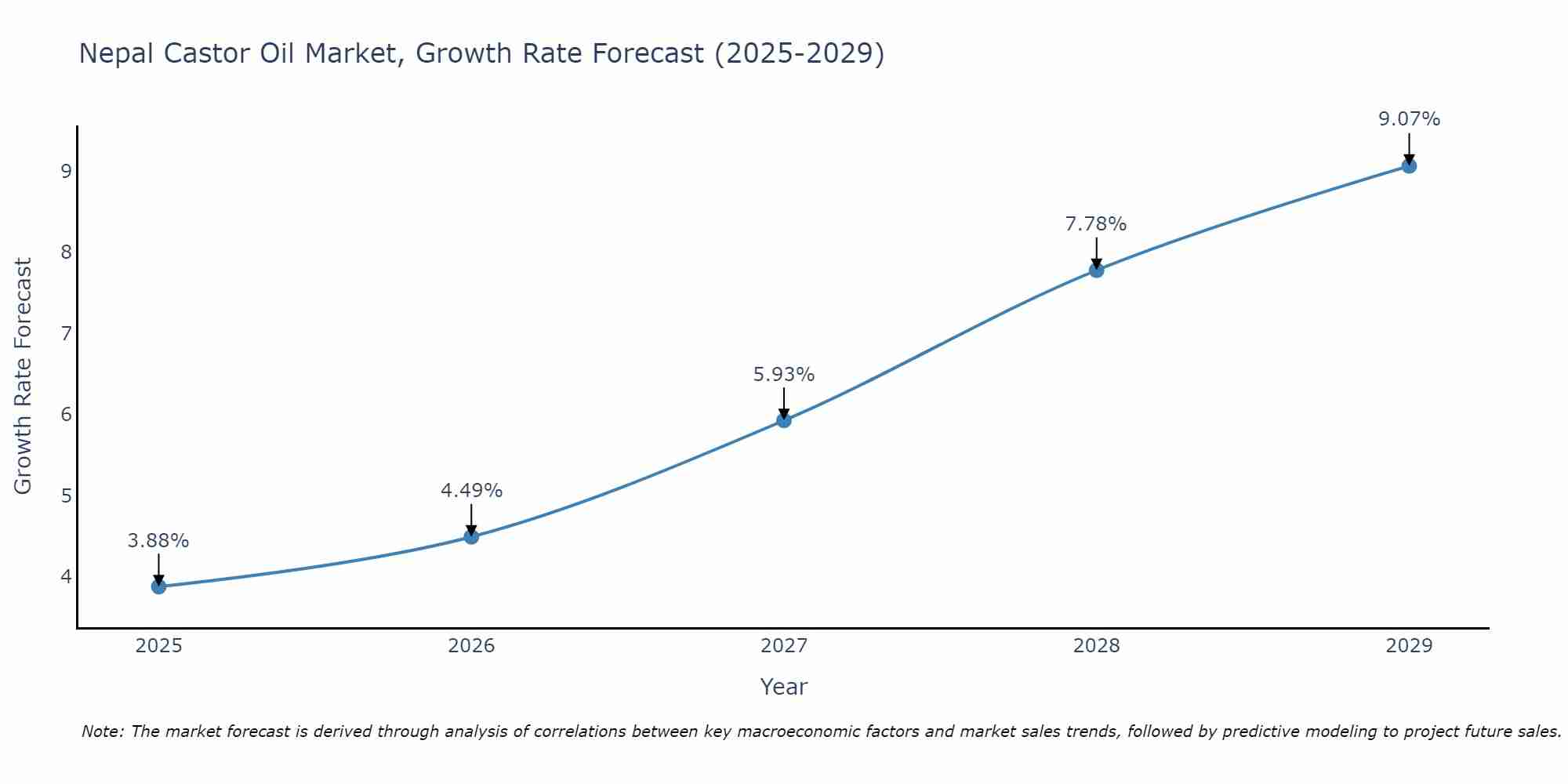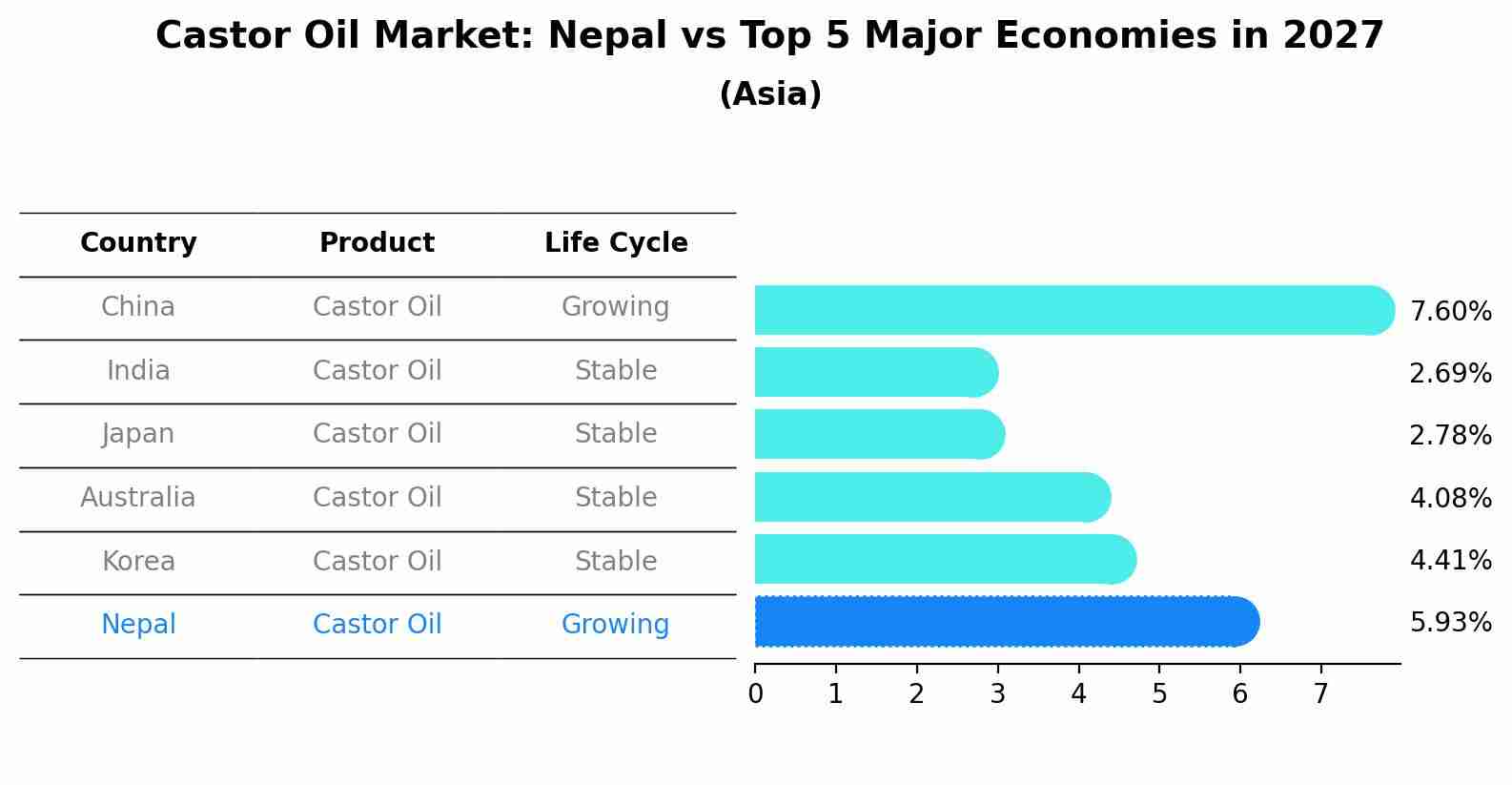Nepal Castor Oil Market (2025-2031) Outlook | Value, Forecast, Companies, Analysis, Share, Revenue, Industry, Size, Growth & Trends
| Product Code: ETC410072 | Publication Date: Oct 2022 | Updated Date: Jul 2025 | Product Type: Market Research Report | |
| Publisher: 6Wresearch | Author: Shubham Padhi | No. of Pages: 75 | No. of Figures: 35 | No. of Tables: 20 |
Nepal Castor Oil Market Size Growth Rate
The Nepal Castor Oil Market is likely to experience consistent growth rate gains over the period 2025 to 2029. Commencing at 3.88% in 2025, growth builds up to 9.07% by 2029.

Castor Oil Market: Nepal vs Top 5 Major Economies in 2027 (Asia)
The Castor Oil market in Nepal is projected to grow at a growing growth rate of 5.93% by 2027, highlighting the country's increasing focus on advanced technologies within the Asia region, where China holds the dominant position, followed closely by India, Japan, Australia and South Korea, shaping overall regional demand.

Nepal Castor Oil Market Synopsis
The Nepal Castor Oil Market is experiencing steady growth due to the increasing demand for castor oil in various industries such as cosmetics, pharmaceuticals, and agriculture. The country`s favorable climatic conditions for castor bean cultivation contribute to a steady supply of raw materials. Additionally, the rising awareness regarding the benefits of castor oil for hair and skin care among consumers is driving the market growth. Local manufacturers are focusing on improving production techniques and expanding their product portfolios to cater to the diverse needs of the market. The market is also witnessing a growing trend towards organic and cold-pressed castor oil products, further fueling market expansion. Overall, the Nepal Castor Oil Market presents opportunities for both domestic producers and international investors looking to capitalize on the growing demand for natural and sustainable products.
Nepal Castor Oil Market Trends
In the Nepal Castor Oil market, there is a growing trend towards organic and sustainably sourced products. Consumers are increasingly seeking natural and chemical-free options, leading to a rise in demand for organic castor oil that is produced using environmentally-friendly practices. Additionally, there is a focus on the health and wellness benefits of castor oil, with a growing interest in its use for skincare, haircare, and medicinal purposes. The market is also seeing an increase in product innovation, with manufacturers introducing new formulations and packaging to cater to evolving consumer preferences. Overall, the Nepal Castor Oil market is witnessing a shift towards eco-friendly, natural, and innovative products to meet the changing needs of consumers.
Nepal Castor Oil Market Challenges
In the Nepal Castor Oil Market, some of the key challenges include limited production capacity, inconsistent quality standards, and competition from larger global suppliers. The local production of castor oil in Nepal is relatively small-scale, leading to supply shortages and price fluctuations. Additionally, the lack of standardized quality control measures makes it difficult for Nepalese castor oil to compete with imported products in terms of consistency and purity. Moreover, the market is also affected by fluctuations in raw material prices and foreign exchange rates, impacting both production costs and pricing strategies. Overall, the Nepal Castor Oil Market faces challenges in terms of production capacity, quality control, competition, and market volatility, which require strategic solutions to enhance competitiveness and sustainability in the industry.
Nepal Castor Oil Market Investment Opportunities
Investment opportunities in the Nepal Castor Oil market include potential growth in demand due to increasing awareness and use of castor oil in various industries such as cosmetics, pharmaceuticals, and biofuels. The country`s favorable climate for castor cultivation and the availability of skilled labor can lead to increased production and exports, providing opportunities for investors to capitalize on the growing market. Additionally, advancements in technology and sustainable practices in castor oil production present opportunities for investment in modernizing processing facilities and improving efficiency. With the global trend towards natural and eco-friendly products, investing in Nepal`s Castor Oil market can offer long-term returns and contribute to the sustainable development of the industry.
Jordan Agar Market Government Policies
The Nepal Castor Oil Market is influenced by various government policies aimed at promoting agriculture and exports. The government of Nepal has implemented policies to support the cultivation of castor oil plants, providing subsidies and incentives for farmers to increase production. Additionally, there are regulations in place to ensure the quality and standards of castor oil produced in the country, promoting consumer confidence and facilitating exports. Importantly, the government also focuses on promoting sustainable practices in the castor oil industry to protect the environment and ensure long-term viability. Overall, the government policies in Nepal aim to boost the castor oil market by supporting local producers, maintaining quality standards, and promoting sustainable practices.
Nepal Castor Oil Market Future Outlook
The Nepal Castor Oil market is expected to witness steady growth in the coming years, driven by increasing demand from various industries such as cosmetics, pharmaceuticals, and agriculture. The rising consumer awareness regarding the benefits of natural and organic products is likely to boost the demand for castor oil as it is known for its numerous health and beauty benefits. Additionally, the growing trend towards sustainable and eco-friendly products is expected to further propel the market growth. However, challenges such as fluctuating raw material prices and limited technological advancements in the production process may hinder the market growth to some extent. Overall, with the right marketing strategies and product innovations, the Nepal Castor Oil market is poised for a positive trajectory in the future.
Key Highlights of the Report:
- Nepal Castor Oil Market Outlook
- Market Size of Nepal Castor Oil Market, 2024
- Forecast of Nepal Castor Oil Market, 2031
- Historical Data and Forecast of Nepal Castor Oil Revenues & Volume for the Period 2021 - 2031
- Nepal Castor Oil Market Trend Evolution
- Nepal Castor Oil Market Drivers and Challenges
- Nepal Castor Oil Price Trends
- Nepal Castor Oil Porter's Five Forces
- Nepal Castor Oil Industry Life Cycle
- Historical Data and Forecast of Nepal Castor Oil Market Revenues & Volume By End Use for the Period 2021 - 2031
- Historical Data and Forecast of Nepal Castor Oil Market Revenues & Volume By Pharmaceuticals for the Period 2021 - 2031
- Historical Data and Forecast of Nepal Castor Oil Market Revenues & Volume By Lubricants for the Period 2021 - 2031
- Historical Data and Forecast of Nepal Castor Oil Market Revenues & Volume By Paints for the Period 2021 - 2031
- Historical Data and Forecast of Nepal Castor Oil Market Revenues & Volume By Soaps for the Period 2021 - 2031
- Historical Data and Forecast of Nepal Castor Oil Market Revenues & Volume By Others for the Period 2021 - 2031
- Nepal Castor Oil Import Export Trade Statistics
- Market Opportunity Assessment By End Use
- Nepal Castor Oil Top Companies Market Share
- Nepal Castor Oil Competitive Benchmarking By Technical and Operational Parameters
- Nepal Castor Oil Company Profiles
- Nepal Castor Oil Key Strategic Recommendations
Frequently Asked Questions About the Market Study (FAQs):
- Single User License$ 1,995
- Department License$ 2,400
- Site License$ 3,120
- Global License$ 3,795
Search
Thought Leadership and Analyst Meet
Our Clients
Related Reports
- Canada Oil and Gas Market (2026-2032) | Share, Segmentation, Value, Industry, Trends, Forecast, Analysis, Size & Revenue, Growth, Competitive Landscape, Outlook, Companies
- Germany Breakfast Food Market (2026-2032) | Industry, Share, Growth, Size, Companies, Value, Analysis, Revenue, Trends, Forecast & Outlook
- Australia Briquette Market (2025-2031) | Growth, Size, Revenue, Forecast, Analysis, Trends, Value, Share, Industry & Companies
- Vietnam System Integrator Market (2025-2031) | Size, Companies, Analysis, Industry, Value, Forecast, Growth, Trends, Revenue & Share
- ASEAN and Thailand Brain Health Supplements Market (2025-2031) | Strategy, Consumer Insights, Analysis, Investment Trends, Opportunities, Growth, Size, Share, Industry, Revenue, Segments, Value, Segmentation, Supply, Forecast, Restraints, Outlook, Competition, Drivers, Trends, Demand, Pricing Analysis, Competitive, Strategic Insights, Companies, Challenges
- ASEAN Bearings Market (2025-2031) | Strategy, Consumer Insights, Analysis, Investment Trends, Opportunities, Growth, Size, Share, Industry, Revenue, Segments, Value, Segmentation, Supply, Forecast, Restraints, Outlook, Competition, Drivers, Trends, Demand, Pricing Analysis, Competitive, Strategic Insights, Companies, Challenges
- Europe Flooring Market (2025-2031) | Outlook, Share, Industry, Trends, Forecast, Companies, Revenue, Size, Analysis, Growth & Value
- Saudi Arabia Manlift Market (2025-2031) | Outlook, Size, Growth, Trends, Companies, Industry, Revenue, Value, Share, Forecast & Analysis
- Uganda Excavator, Crane, and Wheel Loaders Market (2025-2031) | Strategy, Consumer Insights, Analysis, Investment Trends, Opportunities, Growth, Size, Share, Industry, Revenue, Segments, Value, Segmentation, Supply, Forecast, Restraints, Outlook, Competition, Drivers, Trends, Demand, Pricing Analysis, Competitive, Strategic Insights, Companies, Challenges
- Rwanda Excavator, Crane, and Wheel Loaders Market (2025-2031) | Strategy, Consumer Insights, Analysis, Investment Trends, Opportunities, Growth, Size, Share, Industry, Revenue, Segments, Value, Segmentation, Supply, Forecast, Restraints, Outlook, Competition, Drivers, Trends, Demand, Pricing Analysis, Competitive, Strategic Insights, Companies, Challenges
Industry Events and Analyst Meet
Whitepaper
- Middle East & Africa Commercial Security Market Click here to view more.
- Middle East & Africa Fire Safety Systems & Equipment Market Click here to view more.
- GCC Drone Market Click here to view more.
- Middle East Lighting Fixture Market Click here to view more.
- GCC Physical & Perimeter Security Market Click here to view more.
6WResearch In News
- Doha a strategic location for EV manufacturing hub: IPA Qatar
- Demand for luxury TVs surging in the GCC, says Samsung
- Empowering Growth: The Thriving Journey of Bangladesh’s Cable Industry
- Demand for luxury TVs surging in the GCC, says Samsung
- Video call with a traditional healer? Once unthinkable, it’s now common in South Africa
- Intelligent Buildings To Smooth GCC’s Path To Net Zero


















